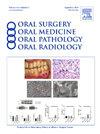嗅觉神经母细胞瘤:21例回顾性分析
IF 1.9
3区 医学
Q2 DENTISTRY, ORAL SURGERY & MEDICINE
Oral Surgery Oral Medicine Oral Pathology Oral Radiology
Pub Date : 2025-07-21
DOI:10.1016/j.oooo.2025.04.030
引用次数: 0
摘要
尽管在鼻窦区存在具有神经内分泌特征的非神经内分泌肿瘤,但神经内分泌肿瘤[NET]可以大致分为神经外胚层来源的神经母细胞瘤[ONB]和上皮来源的神经内分泌癌。对21例ONB进行了全面的回顾。材料和方法回顾性检索OHSU,病理学部门记录[1990-2020]ONB/感觉神经母细胞瘤的ICD代码,重点是建立的纳入标准。采用Kaplan-Meier法和log-rank检验进行统计分析。P <考虑统计学显著性;05.结果Hyams I级38.10%,II级33.33%,III级9.52%,IV级19.05%。以改良Kadish III期和IV期为主(42.86%),其次为I期4.76%和II期9.52%。大多数患者采用手术 + RT/IMRT治疗,其次是手术 + RT/IMRT + 化疗和手术治疗。对于Hyams I级患者,比较了不同Kadish分期的5年和10年复发率:I期[0%,25%],II期[14.3%,48.6%],III期和IV期[50%,100%];10年后,100%的存活率下降到83.1%。结论不同Hyams分级患者预后差异显著[P = ]。[0384]但在改良的卡迪什肿瘤分期中没有显示出相同的结果[P = ]。[3432],表明与Kadish分期相比,Hyams分级更能预测患者预后。本文章由计算机程序翻译,如有差异,请以英文原文为准。
Olfactory neuroblastoma [esthesioneuroblastoma]: a retrospective review of 21 cases
Introduction
Despite the presence of non-neuroendocrine tumors with neuroendocrine characteristics within the sinonasal region, neuroendocrine tumors [NET] may be roughly separated into those derived from neuroectodermal origin, olfactory neuroblastomas [ONB], and those of epithelial origin, neuroendocrine carcinomas. A comprehensive review of 21 cases of ONB is presented.
Materials and Methods
Retrospective search of OHSU, Dept. of Pathology records [1990-2020] ICD codes for ONB/esthesioneuroblastoma, focusing on established inclusion criteria. Statistical analysis was performed using Kaplan–Meier method and the log-rank test. Statistical significance was considered at P < .05.
Results
38.10% presented with Hyams grade I, 33.33% grade II, 9.52% grade III, and 19.05% grade IV. Most patients presented with modified Kadish stages III and IV [42.86%], followed by stages I [4.76%] and II [9.52%]. The majority of patients were managed by surgery + RT/IMRT, followed by surgery + RT/IMRT + chemo and surgery only. For patients with Hyams grade I, the 5- and 10-year recurrence rates were compared across Kadish staging: stage I [0%, 25%], stage II [14.3%, 48.6%], stage III and IV [50%, 100%]; and the 100% survival rate dropped to 83.1% at 10 years.
Conclusion
The current study highlights significant prognostic differences between different Hyams grades [P = .0384] but did not show the same for modified Kadish tumor stages [P = .3432], suggesting that Hyams grading was more predictive of patients’ outcomes when compared to Kadish staging.
求助全文
通过发布文献求助,成功后即可免费获取论文全文。
去求助
来源期刊

Oral Surgery Oral Medicine Oral Pathology Oral Radiology
DENTISTRY, ORAL SURGERY & MEDICINE-
CiteScore
3.80
自引率
6.90%
发文量
1217
审稿时长
2-4 weeks
期刊介绍:
Oral Surgery, Oral Medicine, Oral Pathology and Oral Radiology is required reading for anyone in the fields of oral surgery, oral medicine, oral pathology, oral radiology or advanced general practice dentistry. It is the only major dental journal that provides a practical and complete overview of the medical and surgical techniques of dental practice in four areas. Topics covered include such current issues as dental implants, treatment of HIV-infected patients, and evaluation and treatment of TMJ disorders. The official publication for nine societies, the Journal is recommended for initial purchase in the Brandon Hill study, Selected List of Books and Journals for the Small Medical Library.
 求助内容:
求助内容: 应助结果提醒方式:
应助结果提醒方式:


